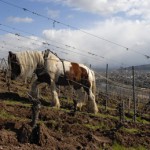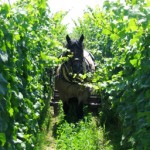In search of minerality
Author: Guest Blogger
Olivier Humbrecht MW, of Domaine Zind Humbrecht in Alsace, converted to biodynamic farming in 1997 after carrying out experiments with the soils in his vineyard. In this interview he talks about how his quest for minerality in wine has lead him down the path to biodynamics.
 Wine Matters: What is minerality in wine?
Wine Matters: What is minerality in wine?
Olivier Humbrecht MW: I often use the word ‘minerality’ to describe a wine that shows a strong sense of place and soil character on the nose. Unfortunately I am partly wrong, because minerals have no odours.
In wines, the mineral nose can often be associated with certain wine making techniques (long lees contact, more reductive vinification, sometimes sulphurs or sulfites) or the absence of some strong varietal characteristics (for example, a Riesling nose will always appear more mineral than a Gewürztraminer because it is less aromatic…).
On the palate, this is another story. Minerals in their globality have a taste and will without doubt influence the palate, length and structure of a wine. Their presence will first alter the pH or expression of the acidity on the palate and change the compositions of many molecules in a wine. More importantly, they will leave a saline savour, enhancing the touch of the wine on our taste buds and transforming its length and character. This ‘minerality’ will also make salivate and will increase the desire to take another sip. As a wine grower, it is this expression of minerality that I am looking for in wines. It makes a wine unique in its character and is a formidable sign of quality, because only great viticulture and careful winemaking can bring this taste in the bottle.
WM: Where do minerals come from?
OH: The soil! But only if the soil is capable of producing them and storing them, and if the roots are capable of finding  them. Minerals are directly linked to the composition of the soil and the mother rock. Different types of soils/mother rock combinations will produce different kinds of minerals in different quantities. Some soils have a specific composition that will allow them to produce interesting minerals. It is possible, just on this criteria, to classify them on a quality scale… Some might be too poor from a mineral point of view to be considered interesting for viticulture and would not be granted Grand Cru status. A soil which is lying on top of an interesting rock base and contains a rich organic-mineral structure, enhanced by numerous and active micro-organisms, has the potential to produce, store and keep for the plants use many interesting minerals.
them. Minerals are directly linked to the composition of the soil and the mother rock. Different types of soils/mother rock combinations will produce different kinds of minerals in different quantities. Some soils have a specific composition that will allow them to produce interesting minerals. It is possible, just on this criteria, to classify them on a quality scale… Some might be too poor from a mineral point of view to be considered interesting for viticulture and would not be granted Grand Cru status. A soil which is lying on top of an interesting rock base and contains a rich organic-mineral structure, enhanced by numerous and active micro-organisms, has the potential to produce, store and keep for the plants use many interesting minerals.
A soil is, in fact, a fragile mechanism. Most human intervention will disrupt a complicated process. First, if a soil doesn’t contain enough organic matter, there will be no humus there to stabilize the fragile clay and minerals. Organic matter can be brought to a soil (composts), but if there aren’t enough micro-organisms, this organic matter (compost, but also dead roots or dead animal organisms) will eventually go through the process of anaerobic fermentation, which will produce CO2, an acid gas, that will in turn invert the soil.
So, if there is no life in soils, there are less and less minerals, and more importantly, soils cannot produce them anymore and the vines will not be able to adsorb them.
WM: What kills life in soils?
OH: Easy: herbicides, chemicals, abusive soil compaction (heavy repetitive machine use, heavy mechanical harvesters), lack of corrective ploughings, no growing plants in the soils (young growing roots help to aerate a soil), because compaction has an asphyxiating effect and when there is no more O2 in a soil, life disappears. Just look what happens when someone always walk on the same track in a garden: it creates a path with no growth. Because when there is no life, plants cannot feed themselves and eventually die.
WM: What brings life into a soil?
 OH: Easy: the use of high quality compost, no chemicals or herbicides, allow oxygen to penetrate into the soil by ploughing it in winter, allowing plants to grow between soil tilling and using lighter, less damaging machines, and also helping the soil to digest all the fresh organic matter it gets every year by using some specific preparations made from cow dung and plants. You must show the vine the direction it has to concentrate its energies… In fact, I realize I just gave some of the basics for bio-dynamic cultivation…
OH: Easy: the use of high quality compost, no chemicals or herbicides, allow oxygen to penetrate into the soil by ploughing it in winter, allowing plants to grow between soil tilling and using lighter, less damaging machines, and also helping the soil to digest all the fresh organic matter it gets every year by using some specific preparations made from cow dung and plants. You must show the vine the direction it has to concentrate its energies… In fact, I realize I just gave some of the basics for bio-dynamic cultivation…
If life helps to keep a soil fertile and helps the vines to find the necessary minerals, and if bio-dynamie enforces life in soils, the result can only be better. It isn’t easy to grow vines in general. This plant doesn’t naturally have the desire to produce fruits (therefore needs to be pruned severely every winter), so it is even more difficult to force a crop, and sometimes a large one, without the drawback of excessive vigour. biodynamic cultivation helps the soil to regain fertility and life without becoming over vigorous. It is a method meant for quality production, not volume. Simple soil analysis (Biodyvin experiments) have showed that bio-dynamic soils would contain ten time more micro-organisms (measured in weight) than normal organic soils. The difference is even greater with conventional viticulture. It is only a small guess to imagine that there is also a direct influence on the minerality of a wine.
Minerality is the ultimate interesting measurement in a wine. It cannot be faked and it is the direct influence of a place on the style of a wine. The taste of minerals is something delicate, that can be hidden or altered with various winemaking techniques, but respectful wine making will always allow the soil to influence a wine. Minerality is what makes the difference between a technological product and the result of a skilful art and a unique product: a wine from a great origin.



I would love there to be a tasting in which there is an analysis of minerality – sometimes I wonder whether certain characters that people describe as minerality are not more to do with use of sulphur in some form.